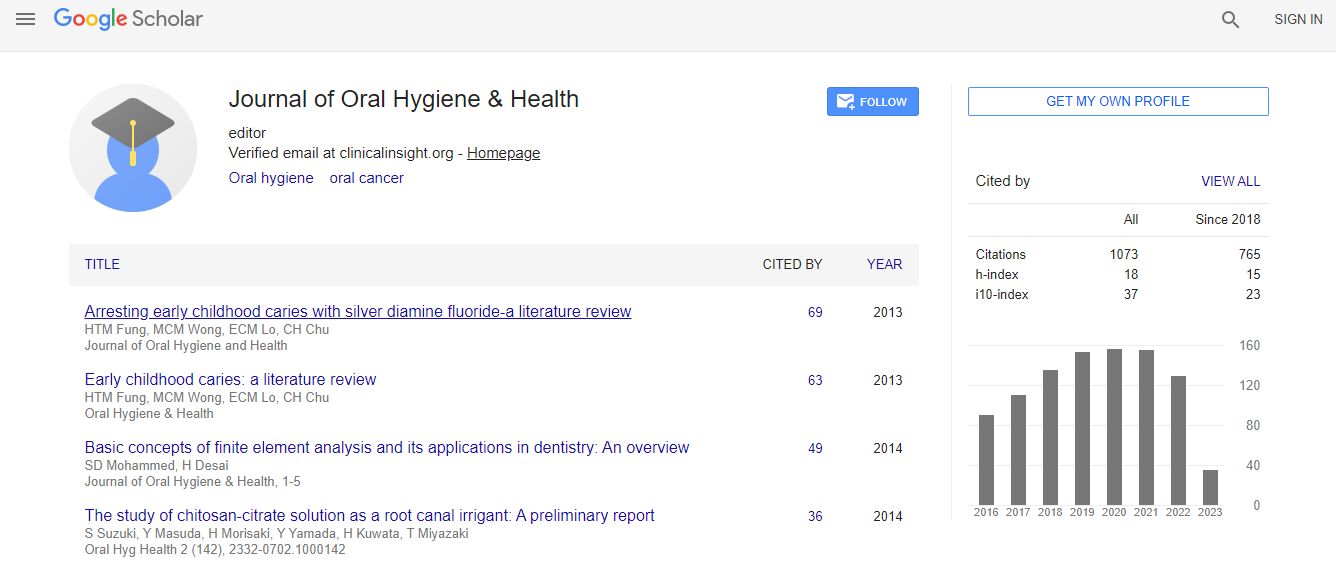Research Article
The Prevalence, Characteristics and Risk Factors in Non-Carious Cervical Lesion: A Survey on 295 People in Guangzhou Area
Wenjuan Yan1* and Dehong Yang2
1 Department of Stomatology, Nanfang Hospital, Southern Medical University, Guangzhou, 510515, China
2 Department of Spinal Surgery, Nanfang Hospital, Guangzhou, 510515, China
- *Corresponding Author:
- Wenjuan Yan
Department of Stomatology
Nanfang Hospital
Southern Medical University
Guangzhou, 510515, China
Tel: 8620-62787149
Fax: 8620-62787149
E-mail: ywj918@sohu.com
Received Date: January 19, 2014; Accepted Date: March 10, 2014; Published Date: March 15, 2014
Citation: Yan W, Yang D (2014) The Prevalence, Characteristics and Risk Factors in Non-Carious Cervical Lesion: A Survey on 295 People in Guangzhou Area. J Oral Hyg Health 2:125. doi:10.4172/2332-0702.1000125
Copyright: © 2014 Yan W, et al. This is an open-access article distributed under the terms of the Creative Commons Attribution License, which permits unrestricted use, distribution, and reproduction in any medium, provided the original author and source are credited.
Abstract
Statement of the problem: An epidemiological cross-sectional survey was performed by trained, calibrated examiners, using a modified version of the TWI.
Purpose: To survey the prevalence, characteristics of non-carious cervical lesion (NCCL) and analyze its relationship with life style.
Methods: We surveyed 295 subjects including 187 males and 108 females who underwent oral health assessment in Nanfang Hospital. The shape, size, location of NCCL, tooth brushing habits, dietary habits, hand preference and bruxism were recorded for analysis.
Results: NCCLs were found in 72.5% of subjects without gender difference. 70.6% affected teeth demonstrated v-shape. 61.2% of the lesions had axial depths of 1 to 2 millimeters. 73.4% of NCCLs were on posterior teeth, 55.6% on maxillary teeth. First premolars (32.3%) were mostly affected. The NCCLs was associated with age (P<0.01) and hard foods (P=0.03), but not bruxism (P=0.77) or frequency of tooth brushing (P=0.92). NCCLs were more common in right-hand tooth brusher (P<0.05 vs left-hander). The Odds Ratio of age, hand preference and hard foods on NCCLs were 1.1, 0.31 and 0.48, respectively.
Conclusions: NCCLs were more common in posterior maxillary teeth, especially first premolars. Senior patients were more likely to have NCCLs. Aging, tooth brush and hard foods are risk factors for NCCLs.The main conclusions of this study the posterior mandibular teeth especially the first premolars followed by the molars were the teeth commonly involved. NCCLs were significantly related to age. No great difference in incidence was found between the right and left sides as a result of right or left hand dexterity. Aging, hard foods and tooth brush are risk factors for NCCLs. The limitations of this study: our survey based on a small sample. Large scale study or meta-analysis based on small samples analysis is needed in the future.

 Spanish
Spanish  Chinese
Chinese  Russian
Russian  German
German  French
French  Japanese
Japanese  Portuguese
Portuguese  Hindi
Hindi 
